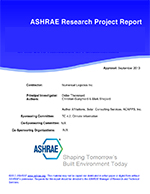Description
This report describes work performed to develop a demonstration knowledge base and implement it in a software system to aid building operators in minimizing energy costs under real-time pricing electricity rates. The knowledge base and associated calculations, as implemented in a demonstration software package, cover the major electrical end-uses of a hotel, which should provide a super-set of the end-uses in office buildings and most other commercial facilities. The software system is written in Visual Basic, which provides the development platform for a Windows-based user interface, along with the M4 KBS shell and a database program. Operators are first asked to provide detailed information about conventional and RTP rates and then to describe whole-building electrical load shapes. In the sample provided with the software, care is taken to adjust raw rate data from a utility to account for revenue reconciliation. From these data, an analysis is performed to calculate a cost duration curve and pin-point hours of high costs. Because on-site generation is typically the first choice of RTP control strategies in buildings so equipped, the software then asks for generator operating information and calculates a threshold electricity price above which the generator should be run, the reduction in electricity costs and off-setting generator costs associated with generator operation. For lights, a knowledge base is used to help operators assess the importance of the service provided by the lights and to recommend a threshold price above which lights would be dimmed, stepped down or turned off. Service assessment is based on the type of space, the extent to which the space is used for essential activity, and the occupancy. This assessment is performed fore each of three shifts per day. With a threshold and control action determined, savings from light control can then be estimated.
A knowledge base is also used to guide building operators in estimating an appropriate swing in indoor temperatures. Larger swings have more impact on occupant comfort but make it possible to shift chiller operation to a larger extent by letting the indoor temperature rise when prices are high and pre- or post-cooling when prices are lower. The use of thermal storage systems’is similar to that of on-site generation, in that occupant comfort is not affected. The storage system should be used to minimize operating costs. Algorithms used in this project for thermal storage and for control of space temperatures perform a first-order approximation to an optimal solution by systematically shifting load from high-priced to low-priced hours.
The last load considered in this project is a miscellaneous electrical load for which the user of the program must provide a load profile and a threshold price above which the load is curtailed. Tabors
Product Details
- Published:
- 1996
- Number of Pages:
- 191
- File Size:
- 1 file , 6.7 MB
- Product Code(s):
- D-RP-833




